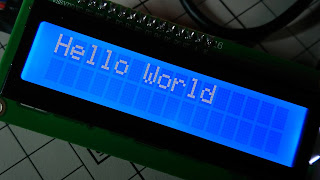"""
LCD1602/2002/2004 I2C adapter driver for Raspberry Pi or other devices
Copyright (C) 2019 SiYu Wu <wu.siyu@hotmail.com>. All Rights Reserved.
"""
__author__ = 'SiYu Wu <wu.siyu@hotmail.com>'
import smbus
import time
name = 'i2clcd'
# Note for developers
#
# I2C byte: [H ------------------------ L]
# [ data ] [ ctrl_bits ]
# PCA8574: P7 P6 P5 P4 P3 P2 P1 P0
# LCD1602: D7 D6 D5 D4 BT E R/W RS
# Define some device constants
LCD_DAT = 0x01 # Mode - Sending data
LCD_CMD = 0x00 # Mode - Sending command
# LINE_1 = 0x80 # LCD RAM address for the 1st line
# LINE_2 = 0xC0 # LCD RAM address for the 2nd line
# LINE_3 = 0x94 # LCD RAM address for the 3rd line
# LINE_4 = 0xD4 # LCD RAM address for the 4th line
LCD_LINES = (0x80, 0xC0, 0x94, 0xD4)
# Character code for custom characters in CGRAM
CGRAM_CHR = (b'\x00', b'\x01', b'\x02', b'\x03', b'\x04', b'\x05', b'\x06', b'\x07')
class i2clcd():
def __init__(self, i2c_bus=1, i2c_addr=0x27, lcd_width=16):
"""
initialize the connection with the LCD
i2c_bus: the smbus where the LCD connected to,
for Raspberry Pi, it should be 1 or 0 (depending on the model)
i2c_addr: I2C address of the adapter, usually 0x27, 0x20 or 0x3f
lcd_width: the width of the LCD, e.g. 16 for LCD1602, 20 for LCD2002/2004
"""
self._bus = smbus.SMBus(i2c_bus)
self._i2c_addr = i2c_addr
self._lcd_width = lcd_width
self._backlight = True
self._last_data = 0x00
def _i2c_write(self, data):
"""write one byte to I2C bus"""
self._last_data = data
self._bus.write_byte(self._i2c_addr, data)
def _pluse_en(self):
"""proform a high level pulse to EN"""
time.sleep(0)
self._i2c_write(self._last_data | 0b00000100)
time.sleep(0)
self._i2c_write(self._last_data & ~0b00000100)
time.sleep(0)
def write_byte(self, data, mode):
"""write one byte to LCD"""
data_H = (data & 0xF0) | self._backlight * 0x08 | mode
data_L = ((data << 4) & 0xF0) | self._backlight * 0x08 | mode
self._i2c_write(data_H)
self._pluse_en()
self._i2c_write(data_L)
self._pluse_en()
time.sleep(0.0001)
def init(self):
"""
Initialize the LCD
"""
# setting LCD data interface to 4 bit
self._i2c_write(0x30)
self._pluse_en()
time.sleep(0.0041)
self._i2c_write(0x30)
self._pluse_en()
time.sleep(0.0001)
self._i2c_write(0x30)
self._pluse_en()
time.sleep(0.0001)
self._i2c_write(0x20)
self._pluse_en()
self.write_byte(0x28, LCD_CMD) # 00101000 Function set: interface 4bit, 2 lines, 5x8 font
self.write_byte(0x0C, LCD_CMD) # 00001100 Display ON/OFF: display on, cursor off, cursor blink off
self.write_byte(0x06, LCD_CMD) # 00000110 Entry Mode set: cursor move right, display not shift
self.clear()
def clear(self):
"""
Clear the display and reset the cursor position
"""
self.write_byte(0x01, LCD_CMD)
time.sleep(0.002)
def set_backlight(self, on_off):
"""
Set whether the LCD backlight is on or off
"""
self._backlight = on_off
i2c_data = (self._last_data & 0xF7) + self._backlight * 0x08
self._i2c_write(i2c_data)
def set_cursor(self, cursor_visible, cursor_blink):
"""
Set whether the cursor is visible and whether it will blink
"""
cmd = 0x0C + cursor_visible * 0x02 + cursor_blink * 0x01
self.write_byte(cmd, LCD_CMD)
def move_cursor(self, line, column):
"""
Move the cursor to a new posotion
line: line number starts from 0
column: column number starts from 0
"""
cmd = LCD_LINES[line] + column
self.write_byte(cmd, LCD_CMD)
def shift(self, direction='RIGHT', move_display=False):
"""
Move the cursor and display left or right
direction: could be 'RIGHT' (default) or 'LEFT'
move_display: move the entire display and cursor, or only move the cursor
"""
direction = 0x04 if direction == 'RIGHT' else 0x00
cmd = 0x10 + direction + move_display * 0x08
self.write_byte(cmd, LCD_CMD)
def return_home(self):
"""
Reset cursor and display to the original position.
"""
self.write_byte(0x02, LCD_CMD)
time.sleep(0.002)
def write_CGRAM(self, chr_data, CGRAM_solt=0):
"""
Write a custom character to CGRAM
chr_data: a tuple that stores the character model data
CGRAM_solt: int from 0 to 7 to determine where the font data is written
NOTICE: re-setting the cursor position after calling this method, e.g.
lcd.write_CGRAM((0x10, 0x06, 0x09, 0x08, 0x08, 0x09, 0x06, 0x00), 2)
lcd.move_cursor(1, 0)
lcd.print(b'New char: ' + i2clcd.CGRAM_CHR[2])
"""
cmd = 0x40 + CGRAM_solt * 8
self.write_byte(cmd, LCD_CMD)
for dat in chr_data:
self.write_byte(dat, LCD_DAT)
def print(self, text):
"""
Print a string at the current cursor position
text: bytes or str object, str object will be encoded with ASCII
"""
if isinstance(text, str):
text = text.encode('ascii')
for b in text:
self.write_byte(b, LCD_DAT)
def print_line(self, text, line, align='LEFT'):
"""
Fill a whole line of the LCD with a string
text: bytes or str object, str object will be encoded with ASCII
line: line number starts from 0
align: could be 'LEFT' (default), 'RIGHT' or 'CENTER'
"""
if isinstance(text, str):
text = text.encode('ascii')
text_length = len(text)
if text_length < self._lcd_width:
blank_space = self._lcd_width - text_length
if align == 'LEFT':
text = text + b' ' * blank_space
elif align == 'RIGHT':
text = b' ' * blank_space + text
else:
text = b' ' * (blank_space // 2) + text + b' ' * (blank_space - blank_space // 2)
else:
text = text[:self._lcd_width]
self.write_byte(LCD_LINES[line], LCD_CMD)
self.print(text)





